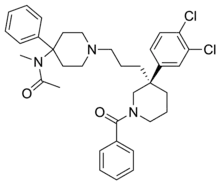Osanetant
 | |
| Clinical data | |
|---|---|
| ATC code |
|
| Identifiers | |
IUPAC name
| |
| CAS Number | |
| PubChem CID | |
| IUPHAR/BPS | |
| ChemSpider | |
| UNII | |
| ChEMBL | |
| ECHA InfoCard | 100.233.307 |
| Chemical and physical data | |
| Formula | C35H41Cl2N3O2 |
| Molar mass | 606.63 g·mol−1 |
| 3D model (JSmol) | |
SMILES
| |
InChI
| |
| | |
Osanetant (developmental code name SR-142,801) is a neurokinin 3 receptor antagonist which was developed by Sanofi-Synthélabo and was being researched for the treatment of schizophrenia but was discontinued.[1][2] It was the first non-peptide NK3 antagonist developed in the mid-1990s,[3][4] Other potential applications for osanetant is in the treatment of drug addiction, as it has been found to block the effects of cocaine in animal models.[5][6]
References
- ↑ "osanetant Sanofi-Aventis discontinued, France". Highbeam. Archived from the original on 2016-03-11.
- ↑ Kamali F (July 2001). "Osanetant Sanofi-Synthélabo". Current Opinion in Investigational Drugs. 2 (7): 950–6. PMID 11757797.
- ↑ Emonds-Alt X, Bichon D, Ducoux JP, Heaulme M, Miloux B, Poncelet M, et al. (1995). "SR 142801, the first potent non-peptide antagonist of the tachykinin NK3 receptor". Life Sciences. 56 (1): PL27-32. doi:10.1016/0024-3205(94)00413-M. PMID 7830490.
- ↑ Quartara L, Altamura M (August 2006). "Tachykinin receptors antagonists: from research to clinic". Current Drug Targets. 7 (8): 975–92. doi:10.2174/138945006778019381. PMID 16918326. Archived from the original on 2011-07-25.
- ↑ De Souza Silva MA, Mello EL, Müller CP, Jocham G, Maior RS, Huston JP, et al. (May 2006). "The tachykinin NK3 receptor antagonist SR142801 blocks the behavioral effects of cocaine in marmoset monkeys". European Journal of Pharmacology. 536 (3): 269–78. doi:10.1016/j.ejphar.2006.03.010. PMID 16603151.
- ↑ Jocham G, Lezoch K, Müller CP, Kart-Teke E, Huston JP, de Souza Silva MA (September 2006). "Neurokinin receptor antagonism attenuates cocaine's behavioural activating effects yet potentiates its dopamine-enhancing action in the nucleus accumbens core". The European Journal of Neuroscience. 24 (6): 1721–32. doi:10.1111/j.1460-9568.2006.05041.x. PMID 17004936. S2CID 29488484.
This article is issued from Offline. The text is licensed under Creative Commons - Attribution - Sharealike. Additional terms may apply for the media files.